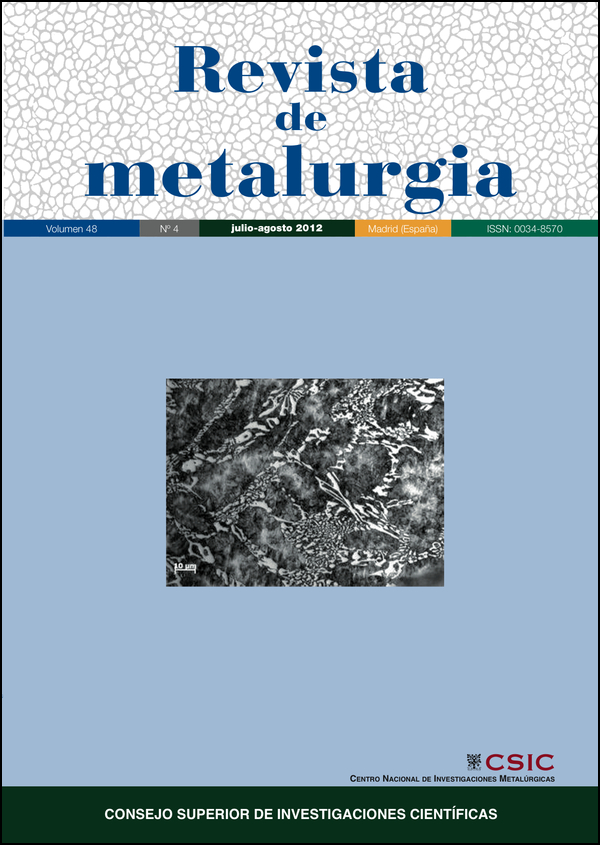Influence of silicon content and heat treatment on wear resistance of white chromium cast irons under high speed solidification conditions
DOI:
https://doi.org/10.3989/revmetalm.1205Keywords:
White chromium cast iron, Heat treatment, Abrasive wear, Dry frictionAbstract
The influence of silicon content and heat treatment on microstructure, abrasive and dry friction wear resistance of a 3 % C, 12 % Cr cast iron, under fast solidification conditions is studied. The fast solidification condition diminishes the carbide volume and the silicon content increases their dispersion and finesses. All matrixes obtained were perlitics, whit different finesses. No intermediate transformation products were noticed. Hardness had little variation. Austenization treatment show little affectivity, with tendency to increase wear in reference to as cast and maintenance treatments. Behavior under dry friction and abrasive wear were similar under test conditions applied whit more influence of carbide morphology in the abrasive wear conditions.
Downloads
References
[1] H. S. Avery, Materials for the mining industry, Climax Molybdenum, Vail, Col., 1974.
[2] J. Dodd y J. L. Parks, Factors affecting the production and performance of thick section high Cr-Mo alloy iron castings, Climax Molybdenum, Greenwich,Conn., 1980.
[3] G. Laird, Trans. AFS 101 (1993) 497-503.
[4] F. Maratray, Bulletin du Cercle dÉtudes des Métaux Novembre (1979) 11-54.
[5] J. L. Parks, Characteristics of as-cast and subcritically heat-treated high Cr-Mo white Irons of thick section castings, Climax Molybdenum, Vail,Col., 1978.
[6] I. Fernández-Pariente y F. J. Belzunce-Varela, Rev. Metal. Madrid 42 (2006) 279-286.
[7] K. A. Kibble y T. H. Pearce, Cast Metals 6 (1993) 9-15.
[8] R. L. Pattyn, Trans. AFS 101 (1993) 161-167.
[9] K. K. Singh, R. S. Verma y G. M. D. Murty, J. Mater.Eng. Perform. 18 (2009) 438-440. http://dx.doi.org/10.1007/s11665-008-9311-8
[10] R. B. Gundlach, Trans. AFS 82 (1974) 309-316.
[11] F. Maratray y R. Usseglio-Nanot, Atlas Transformation characteristics of Cr and Cr-Mo white irons, Climax Molybdenum, Belgium, 1970, p. 198.
[12] Z. Sun, R. Zuo, C. Li, B. Shen, J. Yan y S. Huang, Mater. Charact. 53 (2004) 403-409. http://dx.doi.org/10.1016/j.matchar.2004.09.007
[13] A. Bedolla-Jacuinde, L. Arias y B. Hernández, J. Mater. Eng. Perform. 12 (2003) 371-382. http://dx.doi.org/10.1361/105994903770342881
[14] J. Asensio, J. A. Pero-Sanz y J. I. Verdeja, Mater. Charact. 49 (2003) 83– 93. http://dx.doi.org/10.1016/S1044-5803(02)00260-7
[15] K. H. Zum-Gahr y G. T. Eldis, Wear 64 (1980) 175-194. http://dx.doi.org/10.1016/0043-1648(80)90101-5
[16] O. N. Dogan y J. A. Hawk, Trans. AFS 105 (1997) 167-174.
[17] O. N. Dogan y J. A. Hawk, Wear 189 (1995) 136-142. http://dx.doi.org/10.1016/0043-1648(95)06682-9
[18] C. Cetinkaya, Mater. Design 27 (2006) 437–445. http://dx.doi.org/10.1016/j.matdes.2004.11.021
[19] W. W. Cias, Trans. AFS 82 (1974) 317-328.
[20] L. Wei, J. lron Steel Res. Int. 14(3) (2007) 47-50.
[21] A. Bedolla-Jacuinde y W. M. Rainforth, Wear 250 (2001) 449-461. http://dx.doi.org/10.1016/S0043-1648(01)00633-0
[22] H. Qing-yu, H. Zhen-yi y W. Jing-tao, J. Iron Steel Res. Int. 16(4) (2009) 33-38. http://dx.doi.org/10.1016/S1006-706X(09)60057-1
[23] A. E. Karantzalis, A. Lekatou y H. Mavros, J. Mater. Eng. Perform. 18 (2009) 174-181. http://dx.doi.org/10.1007/s11665-008-9285-6
[24] I. Morales, W. Hormaza y L. Méndez, Revista de Ingeniería de la Universidad de los Andes. Bogotá, Colombia. 30 (2009).
[25] R. L. Pattyn, Trans. AFS 102 (1994) 107-115.
[26] J. Wang, R. L. Zuo, Z. P. Sun, C. Li, H. H. Liu, H. S. Yang, B. L. Shen y S. J. Huang, Mater. Charact. 55 (2005) 234– 240. http://dx.doi.org/10.1016/j.matchar.2005.06.002
[27] J. Wang, C. Li, H. H. Liu, H. S. Yang, B. L. Shen, S. Gao y S. J. Huang, Mater. Charact. 56 (2006) 73–78. http://dx.doi.org/10.1016/j.matchar.2005.10.002
[28] M. J. Santofimia, Tesis Doctoral, Dpto. de Física de Materiales, vol PhD, Univ. Complutense de Madrid, 2006.
[29] R. S. Jackson, JISI 208 (1970) 163-167.
[30] F. Maratray y R. Usseglio-Nanot (Eds.), Factors affecting the structure of chromium and chromiummolybdenum white irons, Climax Molybdenum S.A., Paris,France, 1970, p. 32.
[31] A. Kulmburg, Bulletin du Cercle d’ètudes des mètaux Novembre (1973) 475-490.
[32] L. Ferreiro, Tesis Doctoral, Dpto. de Ing. Industrial II, Universidade da Coruña, Ferrol, 2011.
Downloads
Published
How to Cite
Issue
Section
License
Copyright (c) 2012 Consejo Superior de Investigaciones Científicas (CSIC)

This work is licensed under a Creative Commons Attribution 4.0 International License.
© CSIC. Manuscripts published in both the printed and online versions of this Journal are the property of Consejo Superior de Investigaciones Científicas, and quoting this source is a requirement for any partial or full reproduction.
All contents of this electronic edition, except where otherwise noted, are distributed under a “Creative Commons Attribution 4.0 International” (CC BY 4.0) License. You may read the basic information and the legal text of the license. The indication of the CC BY 4.0 License must be expressly stated in this way when necessary.
Self-archiving in repositories, personal webpages or similar, of any version other than the published by the Editor, is not allowed.
















